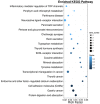Transcriptome Profile in Hippocampus During Acute Inflammatory Response to Surgery: Toward Early Stage of PND
- PMID: 30804943
- PMCID: PMC6370675
- DOI: 10.3389/fimmu.2019.00149
Transcriptome Profile in Hippocampus During Acute Inflammatory Response to Surgery: Toward Early Stage of PND
Abstract
Perioperative neurocognitive disorders (PND) are common complications observed in surgical patients, but there are no effective treatments and the detailed mechanisms remain largely unknown. In this study, transcriptome analysis was performed to investigate the hippocampal changes after surgery and underlying molecular mechanisms of PND. Tibial fracture surgery was performed in 3-4 months old C57BL/6J mice to mimic human orthopedic surgery. We demonstrated that memory consolidation of the hippocampal-dependent trace-fear conditioning task was significantly impaired. By using ELISA, a significant elevated IL-6 was observed both in circulating system and central nervous system and peaked at 6 h post-surgery, but transiently returned to baseline thereafter. Hippocampus were collected at 6 h post-surgery then processed for RNA-Seq. A total of 268 genes were screened differentially expressed between the Surgery and Control group, including 170 up-regulated genes and 98 down-regulated genes. By functional enrichment analysis of differently expressed genes, several KEGG pathways involved in inflammatory mediator regulation of TRP channels, neuroactive ligand-receptor interaction and cholinergic synapse were overrepresented. Quantitative real-time PCR confirmed 15 dysregulated genes of interest. These results provide a comprehensive insight into global gene expression changes during the acute presence of hippocampal inflammation and a better understanding on early stage of PND.
Keywords: RNA-Seq; cognitive dysfunction; hippocampus; neuroinflammation; surgery.
Figures






Similar articles
-
IL-17A contributes to perioperative neurocognitive disorders through blood-brain barrier disruption in aged mice.J Neuroinflammation. 2018 Nov 30;15(1):332. doi: 10.1186/s12974-018-1374-3. J Neuroinflammation. 2018. PMID: 30501622 Free PMC article.
-
Whole-transcriptome sequencing identifies neuroinflammation, metabolism and blood-brain barrier related processes in the hippocampus of aged mice during perioperative period.CNS Neurosci Ther. 2022 Oct;28(10):1576-1595. doi: 10.1111/cns.13901. Epub 2022 Jul 27. CNS Neurosci Ther. 2022. PMID: 35899365 Free PMC article.
-
Complement activation contributes to perioperative neurocognitive disorders in mice.J Neuroinflammation. 2018 Sep 4;15(1):254. doi: 10.1186/s12974-018-1292-4. J Neuroinflammation. 2018. PMID: 30180861 Free PMC article.
-
Research Progress of Hippocampal Dopamine System Changes in Perioperative Neurocognitive Disorders.J Integr Neurosci. 2024 Feb 19;23(2):38. doi: 10.31083/j.jin2302038. J Integr Neurosci. 2024. PMID: 38419449 Review.
-
Defining the role of Interleukin-6 for the development of perioperative neurocognitive disorders: Evidence from clinical and preclinical studies.Front Aging Neurosci. 2023 Jan 26;14:1097606. doi: 10.3389/fnagi.2022.1097606. eCollection 2022. Front Aging Neurosci. 2023. PMID: 36778590 Free PMC article. Review.
Cited by
-
The NLRP3 inflammasome is a potential mechanism and therapeutic target for perioperative neurocognitive disorders.Front Aging Neurosci. 2023 Jan 4;14:1072003. doi: 10.3389/fnagi.2022.1072003. eCollection 2022. Front Aging Neurosci. 2023. PMID: 36688154 Free PMC article. Review.
-
Electroacupuncture ameliorates postoperative cognitive dysfunction and associated neuroinflammation via NLRP3 signal inhibition in aged mice.CNS Neurosci Ther. 2022 Mar;28(3):390-400. doi: 10.1111/cns.13784. Epub 2021 Dec 23. CNS Neurosci Ther. 2022. PMID: 34951130 Free PMC article.
-
Effects of different types of non-cardiac surgical trauma on hippocampus-dependent memory and neuroinflammation.Front Behav Neurosci. 2022 Aug 10;16:950093. doi: 10.3389/fnbeh.2022.950093. eCollection 2022. Front Behav Neurosci. 2022. PMID: 36035019 Free PMC article.
-
Hippocampus-Based Mitochondrial Respiratory Function Decline Is Responsible for Perioperative Neurocognitive Disorders.Front Aging Neurosci. 2022 Feb 9;14:772066. doi: 10.3389/fnagi.2022.772066. eCollection 2022. Front Aging Neurosci. 2022. PMID: 35221986 Free PMC article.
-
Role of lipocalin-2 in surgery-induced cognitive decline in mice: a signal from neuron to microglia.J Neuroinflammation. 2022 Apr 12;19(1):92. doi: 10.1186/s12974-022-02455-5. J Neuroinflammation. 2022. PMID: 35413913 Free PMC article.
References
Publication types
MeSH terms
Substances
LinkOut - more resources
Full Text Sources

